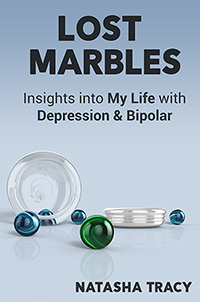As many people know from my last post on hypomania, last week I was filmed for a documentary by Andy Fiore. The documentary is about bipolar disorder and I was one of three people interviewed. Michael Schratter of Ride Don’t Hide, an international tour and movement to battle mental illness stigma, was also interviewed.

Stress Leads to Bipolar Hypomania
I’m not sure how your average person deals with stress. Bingeing? Talking? Ranting? Raging? Running? I just don’t know. As far as I can see, people do all those things when they’re stressed.
But for a person with bipolar disorder, stress can lead to hypomania. And one has to deal with the stress and deal with the hypomania combined – which is kind of stressful in and of itself.
I’m Stressed
Tomorrow I’m being filmed for a documentary by Andy Fiore of Fiore Films. It is for a documentary about people who have learned to successfully live with bipolar disorder. As many of us do, I successfully live with bipolar disorder type 2 even if it’s a rocky path much of the time. And one might argue, I have turned my bipolar disorder into a positive by becoming a mental health writer and helping create a positive path for others living with bipolar disorder.
OK. Fine. But I kind of can’t breathe.
But I admit, I’m nervous. Stressed. I’m stressed about appearing on camera. Even though I do a video spot for HealthyPlace once a month, I still don’t feel particularly comfortable looking into the black abyss of a camera lens.
Have You Had ECT? Help Others and Tell Me Where
As many of you know I’m writing a book on electroconvulsive therapy (ECT). This book will hopefully answer all the questions a person might have before undergoing ECT treatment as well as share with them my personal experience and the experience of others.
And I’ve decided to include, at the back of the book a list of hospitals that offer ECT to help people who want the treatment with a starting point on how to get it.
There’s just one problem – there’s no central repository on who offers ECT treatment.
Please Help Me with the List of Hospitals that Offer ECT
So I’m asking for your help. If you know of a facility that offers ECT, please let me know in the comments below and I’ll add it to the list. You’ll be helping me and helping others as well. Please include hospitals in Canada and the US.
And, of course, if you have any questions about ECT, also feel free to comment on those and I’ll make sure the answers are here and in the book.
Thanks.
Emotional Overreactions and Depression
Yesterday I was having a good day. This doesn’t happen to me all that often but I was being all productive and downright cheery. Miracles. Every day.
But then something happened. It wasn’t an earth-shattering thing, it was just a thing. A life thing. A thing that your average person would feel bad about but not the end of the world.
Just the end of my world.
Depression
Depression is a funny thing. Not so much funny ha ha but more funny want to slit your throat. Depression makes you believe things that aren’t true. Depression makes you believe that you are lowly, that you are nothing, that you are unlovable, that you are unlikeable, and a host of other things all seemingly designed to tear you to the floor.
And it’s really unfortunate when life events work to confirm, or seemingly confirm, these false beliefs.
Best of Bipolar Bites and Breaking Bipolar Blogs
Hi all. A lot happens around these parts in six weeks. As most of you know this month I launched a new blog on Healthline.com called Bipolar Bites and, of course, I still have my blog on HealthyPlace.com called Breaking Bipolar.
Bipolar Bites and Breaking Bipolar Articles
In case you haven’t kept up with your reading, here’s the best of what you might have missed in the last couple of months from both blogs:
- A discussion on the unique mental illness therapy deep brain stimulation and bipolar disorder in two parts: New Treatment for Bipolar – What is Deep Brain Stimulation? and Does Deep Brain Stimulation Work for Bipolar Disorder?
- Bipolar Disorder and Fixing Your Circadian Rhythm – The start of several article on light, darkness and your circadian rhythm in bipolar disorder.
- Can Treatment Noncompliance be Good? – An idea that is hard to bring up without seeming to endorse treatment noncompliance. Is treatment noncompliance sometimes the right thing?
- Lack of Understanding of Mental Illness and sometimes even Hatred Towards the Bipolar Community – it’s difficult for someone without a mental illness to understand what someone with a mental illness goes through every day. Here is some of what I go through that I don’t think people understand.
- Is Bipolar a Personality Disorder? – a question that gets asked frequently along with questions about bipolar disorder and identity.
- Mental Illness as a Disability – can we handle the idea that mental illness really is a disability like any other?
- Bipolar Depression and Feeling Nothing at All – a rarely discussed part of bipolar disorder – feeling nothing at all.
- Bipolar Disorder, Depression and Psychosis – psychosis, delusions and hallucinations, isn’t just a part of schizophrenia, as many of us know too well, it’s a part of bipolar mania, and even depression, as well. Recognition of Irritation and Anxiety is also important.
- Telling Your Family You Have a Mental Illness – You’re Not OK – we all face the battle of telling others about our illness, how do we do it and what do we do if family members remain in denial anyway?
- Why Didn’t Evolution Cull Bipolar Disorder? – Bipolar Benefits – are their evolutionary benefits to having bipolar disorder?
Oh, and the mental health resources page has been updated. Check it out.
If there’s a topic you’d like to see covered feel free to leave a comment below and I’ll see if it tickles my fancy.
Why My Mental Health Opinions Aren’t Just About Me
Let me share a little secret with you – I don’t agree with all mental health treatment. I don’t agree with all the decisions doctors make. I don’t like all the available treatments. I have had very bad experiences with some mental health treatments. I have had some very bad experiences with mental health care professionals.
But I still talk about them. And I still think they are right for some people.
Why?
Because my story isn’t your story.
Acceptance of Bipolar Disorder is a Process
I remember the day, or rather, the night, about 13 years ago when I discovered I had bipolar disorder. I did exactly what I tell people not to do: I went online and diagnosed myself. In my case, I happened to be right.
I remember the extreme pain, fear and shame I felt at realizing I had a mental illness. I remember the indignation I felt at the idea that I would have to take medication for the rest of my life. Mostly though, I remember the tears. I remember the candy apple-red face stained with hundreds of tears. That’s what I remember the most.
But that was 13 years ago and a lot has happened since. One thing I have learned though is that I didn’t accept my mental illness that night. Nor the next. I didn’t truly accept my mental illness for years.
Reader Discretion is Not Advised
Recently a couple of my posts / links / images raised eyes with some of my readers. Some complained and others requested that I put content warnings in front of them.
Well, I don’t do content warnings.*
In this case, one post was about self-harm and had a picture of a cutter’s arm. Another post contained a link to the TV-promo for a Dr. Oz show on electroconvulsive therapy, in which a person gets ECT. Images of self-harm and ECT, it was argued, are very upsetting to some people.
Well, yes.
Nevertheless, in neither case did I think a warning was appropriate.
Here’s why: you’re an adult. Grow up.
Stopping Self-Harm Urges Using Dialectical Behavior Therapy (DBT)
If you feel you may harm yourself, get help now.
I talked about dialectical behavior therapy (DBT) in the last post. Dialectical behavior therapy is designed to work specifically with borderline personality disorder and part of this disorder is often self-harm so DBT uses specific techniques to try to stop self-harm urges and prevent self-harm.
What is Self-Harm?
Self-harm is a huge problem for many people. It is typically a sign of borderline personality disorder but it can occur with any disorder (or no diagnosis at all). Self-harm, also known as self-mutilation or self-injury, can be any form of self-abuse including cutting, burning, hitting and statistics often include those with eating disorders as well. Millions of people in the US practice some form of self-harm.
Self-harm is often practiced by teens and is more common in women than in men, but make no mistake about it, many adults self-harm and men do as well. It is a behavior to be taken seriously. Here are some techniques to stop self-harm urges.
Dialectical Behavior Therapy for Borderline Personality Disorder
In spite of what some people intimate, I do endorse non-drug solutions and one of the best adjunct treatments to medications is psychotherapy. Many types of therapy can work for different people, but one current and research-backed therapy is Dialectical Behavior Therapy (DBT).
Now, don’t let the big words scare you – this is not a scary therapy. This is simply a therapy that works to use reason to integrate and synthesize to opposite points of view. Meaning, the techniques taught are designed to find a balance in emotion, behavior and acceptance.
 Dialectical Behavior Therapy and Borderline Personality Disorder
Dialectical Behavior Therapy and Borderline Personality Disorder
Dialectical behavior therapy was designed specifically to treat borderline personality disorder; however, it has shown usefulness in mood disorders and research is currently underway to see if DBT techniques are also useful in other disorders. This therapy represents a huge breakthrough as the first indicated treatment of borderline personality disorder.
Nominate a Superior Mental Health Advocate for $10,000
The National Council is an organization I recently become involved with as they have asked me to speak at their conference in Chicago this April.
The National Council
In their words, this organization,
… is the unifying voice of America’s behavioral health organizations. Together with our 1,950 member organizations, we serve our nation’s most vulnerable citizens — more than 6 million adults and children with mental illnesses and addiction disorders. We are committed to providing comprehensive, quality care that affords every opportunity for recovery and inclusion in all aspects of community life.
The National Council advocates for public policies in mental and behavioral health that ensure that people who are ill can access comprehensive healthcare services. And we offer state-of-the-science education and practice improvement resources so that services are efficient and effective.
 From what I can tell, this organization believes in community care over hospitalization, advocates for people with a mental illness and are just one quality organization.
From what I can tell, this organization believes in community care over hospitalization, advocates for people with a mental illness and are just one quality organization.
And they’re giving away $10,000.
Amazing right? Well, I sure think so.
The Reintegration Awards
The awards are known as the Reintegration Awards and there are nine categories. The Reintegration awards have, for 15 years,
… celebrated the achievements of those in the community who dedicate themselves to improving the lives of individuals with serious mental illnesses, and the achievements of those living with schizophrenia or bipolar disorder who battle tremendous odds to improve their own lives and the lives of their peers.
And, as fun as it would be, the $10,000 is actually granted to an organization of the individual’s choice, and not the individual themselves. Most of us, though, would be thrilled to give a $10,000 cheque to a deserving organization.
So, please nominate a spectacular mental health advocate or worker here. People who work hard for us deserve our support. And act fast because nominations close on the 31st of January.
Learn more about The National Council’s initiative here.
Dr. Oz Show – The Shock That Could Save Your Life – Electroshock Therapy for Depression
As many people know the Dr. Oz show, did 30 minutes today on electroshock therapy. I’m going to talk a little about the Dr. Oz show’s representation of electroshock therapy and add a few additional facts.
First off, the Dr. Oz show is a source of entertainment, like anything else on TV, so he added drama that wasn’t particularly necessary. That is the way of the show, and TV, however. Specifically, the show started off with scenes of electroshock therapy being given pre-1950 which is when you see people having convulsions in the bad old days before people were anesthetized during treatments. This is not the best way to start a show that is supposed to educate about current treatment, but he does balance this later on.
The Good About the Dr. Oz Show
I was impressed really. They did do a lot of things right and they did share a lot of facts about electroshock therapy, now known as electroconvulsive therapy (ECT). What the Dr. Oz show did right:
- Represented the modern procedure accurately and even showed the procedure being performed
- Mentioned repetitive transcranial magnetic stimulation (rTMS) as an alternative therapy (rTMS uses magnetic waves rather than electricity)
- Stated that almost all insurance companies cover ECT (to the best of my knowledge this is true)
- Spoke that it should be used judiciously
- Placed it in a reasonable historical context
- Tried to reduce stigma and fear and increase awareness around the procedure
- Mentioned memory loss (twice) as a side effect
The Bad about the Dr. Oz Show on Electroconvulsive Therapy (ECT)
As with all things in life, nothing is perfect. Some things you should know that weren’t altogether accurate about the show:
- Only talked about right unilateral brief-pulse ECT – while this is considered the most modern form of ECT it is not the only type. Before getting ECT you need to know what type you are getting in order to accurately judge the risks.
- Stated that ECT “reset the chemical messengers / receptors” in the brain – the truth is we don’t know exactly how ECT works, we only know that it does. It’s likely it works in multiple ways but “resetting chemical messengers / receptors” is mostly just a simplified concept and not medically accurate or at the very least, not medically complete.
- Didn’t mention the other side effects of ECT – while memory loss is generally considered the most concerning, other side effects are also possible.
Altogether, I thought it was a good show, and if a tad flamboyant, represented ECT well but there are other things you should be aware of.
















Recent Comments